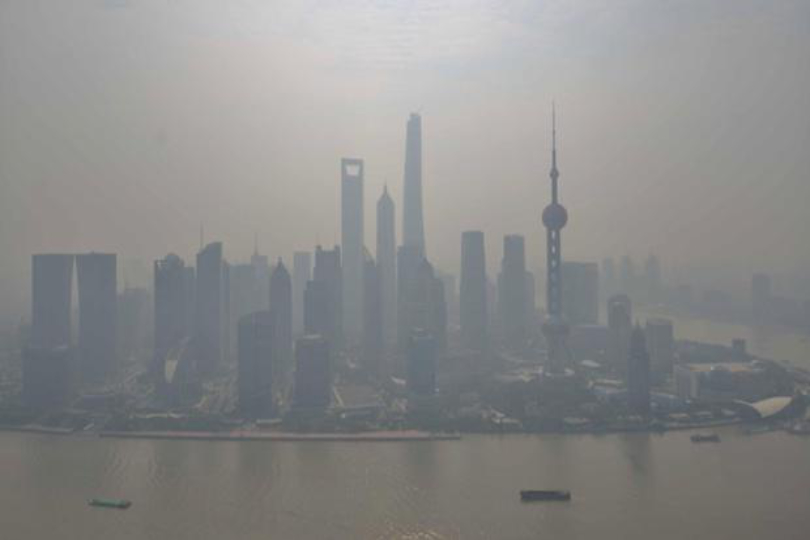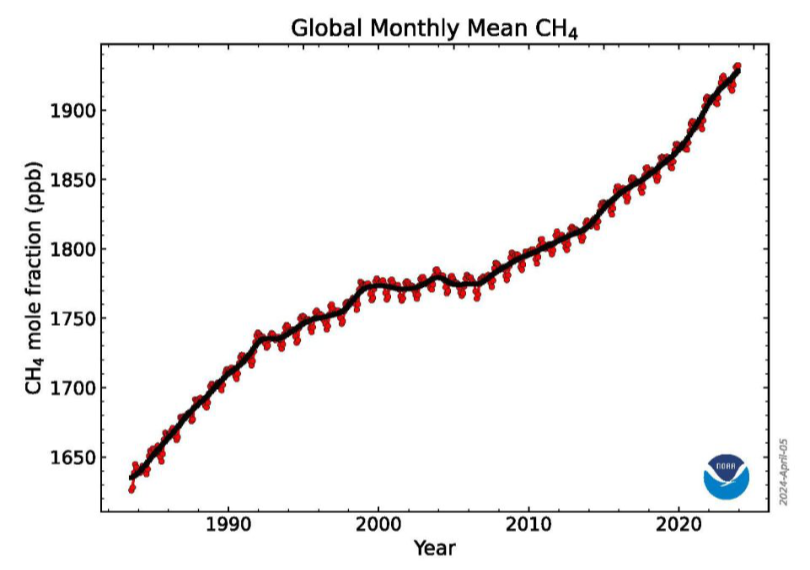Top 3 Greenhouse Gases Spike in 2023
ON 04/08/2024 AT 01 : 27 AM

According to the National Oceanic and Atmospheric Administration (NOAA)’ s Global Monitoring Laboratory (GML), the only good news in its April 5, 2024, summary of atmospheric concentrations of emissions most responsible for global heating and the climate crisis was that the rates of growth of CO2, NH4 (methane), and N2O (nitrous oxide) last year were overall not as high as in some recent years.
That result gives at best just slight cold comfort to those concerned about the future fate of the planet as the news demonstrates that collectively governments and corporations have neither the desire nor the discipline to do what is necessary to keep those emissions in check.
According to the International Monetary Fund, globally, fossil fuel subsidies in 2022 for the highly profitable industry were $7 trillion or 7.1 percent of GDP, reflecting a $2 trillion increase since 2020.
China, India and several other countries continue to double-down on coal and build coal-fired power plants as fast as possible.
The data used to calculate the increases in all three greenhouse gases described in this report comes from the most extensive worldwide database ever put together on this. To come up with the numbers, NOAA gathered more than 15,000 air samples from certified monitoring stations in 53 countries, plus a set of 20 “tall tower” stations located throughout the globe, plus a system involving aircraft monitoring of higher-altitude atmospheric samples, the latter mostly taking place over North America.
The growth in carbon dioxide emissions retained in the atmosphere was the most concerning of the three. Data from the GML showed average global surface concentrations of CO2 rising by 2.2 ppm (parts per million) to an annual average record 419.3 ppm. That makes the twelfth year in a row that carbon dioxide concentrations rose by over 2 ppm.
It also continues a sad track record of the longest continuous rise at that rate or more in the entire six-and-a-half decades NOAA has been monitoring this sort of data. As NOAA noted in its reports, the world had not seen continuous rises of 2 ppm or more for even three consecutive years prior to 2014.
Carbon dioxide concentrations close to the surface of the Earth are also now a full 50% higher than they were prior to the beginning of the industrial revolution.

According to Xin Lan, a scientist from the Cooperative Institute for Research in Environmental Sciences (CIRES), a distinguished research institute affiliated with the University of Colorado Boulder which works closely with NOAA in understanding the trends behind changes in greenhouse gas emissions, the jump in CO2 concentrations from 2022 to 2023 appears linked to a particularly challenging El Niño period last year combined with stepwise increases in the burning of oil and gas for power and transportation.
“The 2023 increase is the third largest in the past decade, likely a result of an ongoing increase of fossil fuel CO2 emissions, coupled with increased fire emissions possibly as a result of the transition from La Nina to El Nino,” Lan said as the latest NOAA report was issued.
Atmospheric methane concentrations also rose substantially in 2023. Its new high of 1922.6 parts per billion was 10.9 ppb higher than last year’s value of 1911.7 ppb. That represents the fifth highest increase in methane in a single year since methane concentrations began releasing rapidly around the globe starting in 2007. The top three increases in methane concentration happened in 2020 with a net gain of 15.2 ppb), in 2021 when values jumped by 18 ppb (understood to be tied to post-pandemic economic and business growth), and 2022 when that growth helped drive another 13.2 ppb of methane increases.
While methane is a much smaller contributor to trapping of infrared heat from solar energy hitting the planet than carbon dioxide, it is proportionally far more efficient in doing so. According to the latest scientific data, for the first twenty years that methane remains in the atmosphere, methane can trap as much as 80 times the heat that carbon dioxide can. After those twenty years have passed, methane breaks down slightly but its still 20 times as efficient heat-trapping ability as carbon dioxide still makes the relative growth in methane emissions a major problem for us all.
Methane concentrations in the air are now 160% higher than they were before the industrial revolution of the mid-19th century.

Unlike carbon dioxide, the increase in CH4 concentrations in the atmosphere is about far more than the consumption of fossil fuels.
60% of all methane which makes its way into the atmosphere as a result of human activities, and comes from leaks and waste from the drilling for and transport of methane across pipelines, incomplete burning of methane as a power source (so that excess amounts escape), raising of livestock for dairy or meat and their associated burps and other gaseous release, agricultural uses including spreading of manure and other fertilizers, sewage treatment and waste disposal, and rotting of items disposed of in public landfills.
The remaining approximately 40% of all methane outputs come from wetlands decay, microorganisms operating in ocean environments which are now hotter and more conducive to organic decay, wildfires resulting from higher temperatures and drought (and which represent a self-reinforcing form of climate-crisis-related emissions which also includes carbon dioxide outputs), the growth of termites as temperatures rise and they release methane while consuming wood products, and releases from geologic sources such as fissures along the ocean floor and within reservoirs. Another natural contributor to methane outputs which has grown since global temperatures accelerated their rise in the 21st century comes from the melting of previously protected permafrost even during the winter. The melting exposes previously trapped organic materials which rapidly decompose, releasing methane at record rates.
A further factor in the increases of methane over the last decade comes from ocean warming. As that occurs, methane hydrate, a frozen form of the gas, can warm enough to “sublime” from a benign frozen crystalline form into the toxic energy-trapping gas. That is of major concern along coastal areas, where recent subsurface research expeditions have determined those previously locked-in methane sources are becoming increasingly unstable.
CIRES scientists Xin Lan also weighed in on this discovery as the latest NOAA methane data came in.
“In addition to the record high methane growth in 2020-2022, we also observed sharp changes in the isotope composition of the methane that indicates an even more dominant role of microbial emission increase,” he reported.
Nitrous Oxide (N2O), the third largest contribution to greenhouse gas concentrations in the atmosphere, went up in 2023 by 1 ppb to 336 ppb. As with the other two greenhouse gas increases from last year, this was not the largest jump in N2O since data began being tracked but it was not far below the previous peak increases. Those occurred in 2020 and 2021, with jumps of 1.3 ppb each in total nitrous oxide concentrations compared to the years previous.
62%, just shy of two-thirds of all nitrous oxide emitted from the planet, comes from natural rather than human causes. Much comes from gas trapped in soils or in the ocean and is released as the coverage above them is disturbed for whatever reasons.
Human causes account for 38% of all nitrous oxide releases, of which a full two-thirds of that (67%) comes from the application of nitrogen-rich fertilizers both synthetic and from manure, plus associated runoff from them. Various industrial processes, plus fossil fuel burning, biomass burning, and human sewage also contribute to the total amount of N2O released into the air every year.
According to NOAA’s analytical laboratories for GML operating at the University of Colorado at Boulder, most of the recent increases in nitrous oxide atmospheric concentrations comes from the use of nitrogen-enhanced fertilizers associated with agricultural intensification throughout the planet, and the microbial breakdown of those fertilizers.
Organic agriculture releases far less N20 but most countries continue to suppress natural agriculture while subsidizing the most destructive industrial agricultural.
Nitrous oxide atmospheric concentrations are now 25% above the 270 ppb value they represented in the pre-industrial age.
Of these three greenhouse gases, carbon dioxide continues to be the focus for most emission control recommendations globally mostly because of their outsized effect on global temperature rise. The vast amount of CO2 also unfortunately contributes to accelerating acidification of the ocean, particularly in its upper layers. That kills off many of the most important living creatures in the ocean, including a significant fraction of the phytoplankton, minute living organisms which drift with the ocean currents and provide one of the most fundamental parts of the global marine food chain.
Going forward, while efforts to decrease emissions globally still mostly target decreasing carbon dioxide emissions, scientists and policy makers are pointing to the rise of methane emissions – and their potential for growing explosively within just decades at most – as something the world needs to do far more about.
As Rob Jackson, the head of the Global Carbon Project, a research effort headquartered at Stanford University, said regarding the results NOAA just published, “Methane's decadal spike should terrify us.”
"Fossil fuel pollution is warming natural systems like wetlands and permafrost," Jackson continued. "Those ecosystems are releasing even more greenhouse gases as they heat up. We're caught between a rock and a charred place.”
The Arctic holds vastly more greenhouse gases than all human contributions for all time and as it heats up it will continue to release all that CO2, methane and nitrous oxide at an accelerating pace.
